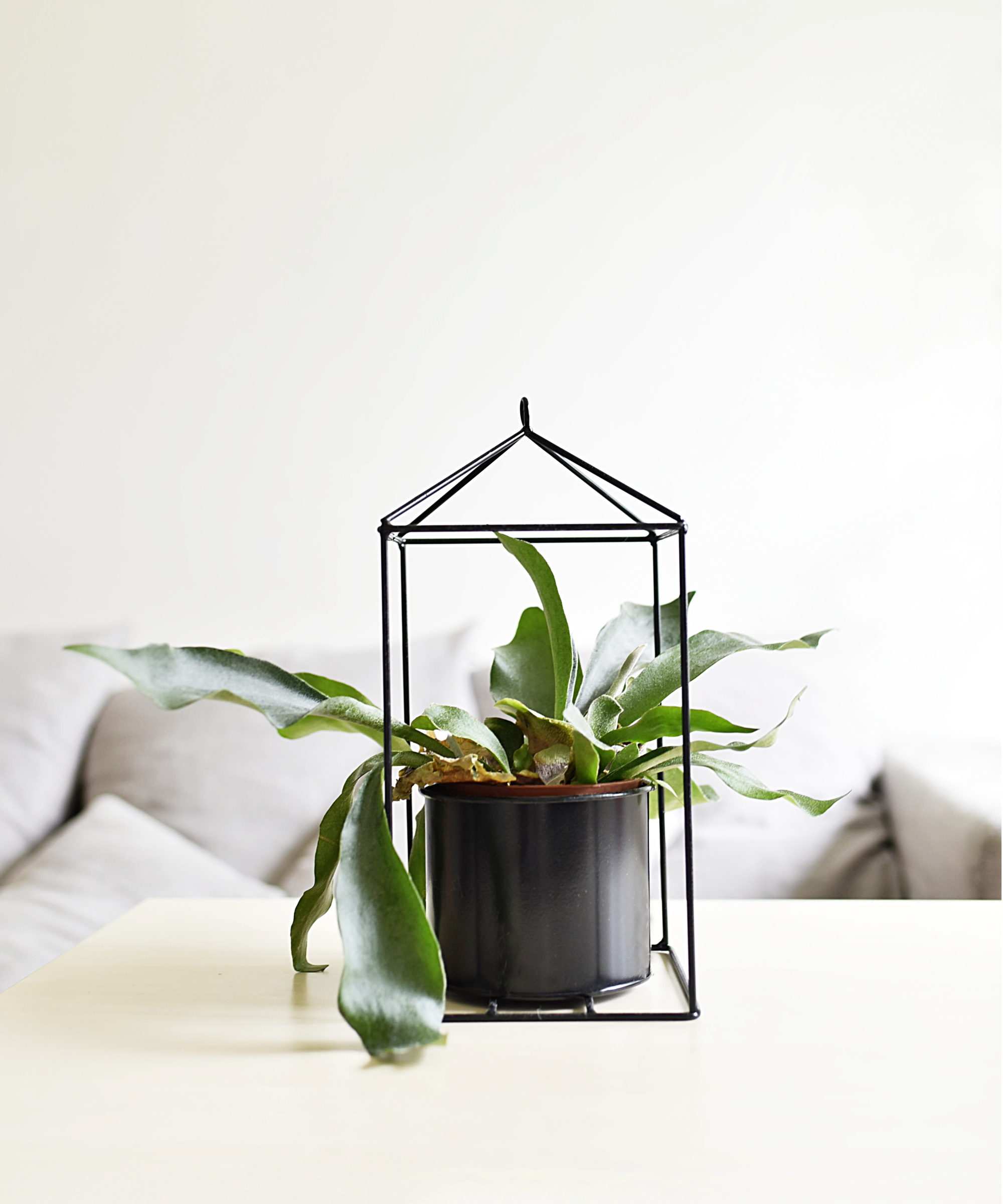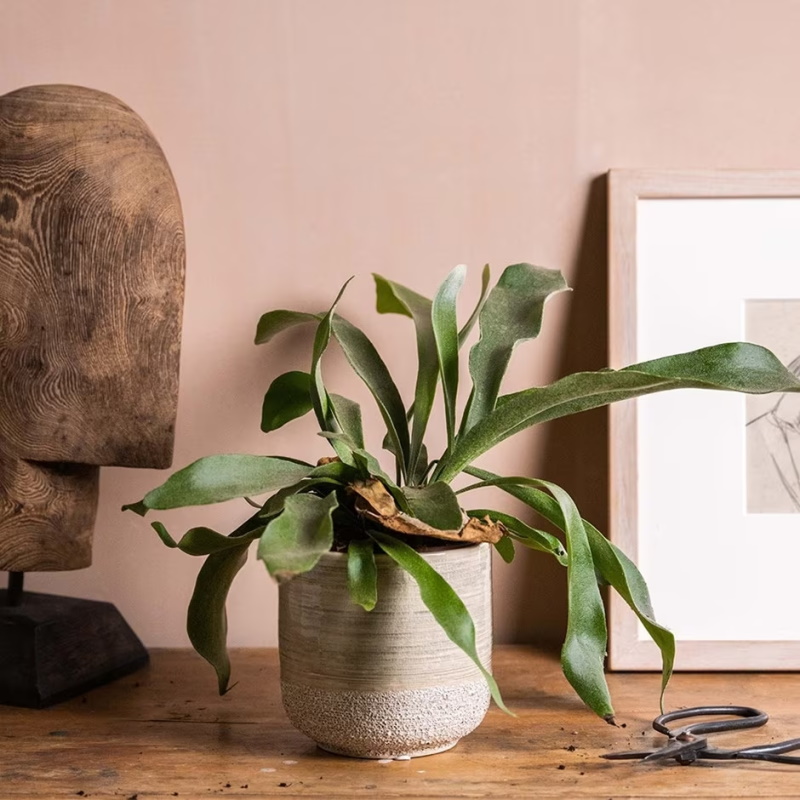Staghorn fern care guide – 5 expert tips for this unusual houseplant
The blue-green foliage and interesting shape of these ferns will bring a tropical feel to your interiors


Among the best indoor ferns is a staghorn fern, an indoor plant with blue-green foliage of unusual shape - reminiscent of forked antlers - which arches in an elegant way.
In its natural environment staghorn ferns, or Platycerium bifurcatum, are found in the tropical forests of Africa, Australia and Southeast Asia. However, they don't grow like the other ferns you may know.
'Staghorn ferns are epiphytes. That is, they attach themselves to other plants in the wild,' says Julia Omelchenko, botany expert for the Plantum app.
These unusual houseplants grow on the trunks and branches of trees, among other plants, in their natural environment. They don't gain nutrients from soil but rather from the air and the plants they are growing on.

And that isn't the only interesting thing about them; staghorn ferns have two types of fronds - sterile and fertile.
'Hard, round sterile fronds grow at the plant’s base, serving primarily to protect the roots and facilitate water and nutrient absorption. Sterile fronds remain green in fall and turn yellow and dry in spring and summer. It's important not to remove these leaves, as they provide essential nutrition to the roots,' Julia says.
'Big, impressive-looking fertile fronds are responsible for the plant's name, as they resemble the antlers of a stag. These fronds play a crucial role in reproduction, featuring brown spores, also known as sporangia, on their undersides,' she adds
Design expertise in your inbox – from inspiring decorating ideas and beautiful celebrity homes to practical gardening advice and shopping round-ups.
Outdoors, staghorn ferns thrive in US hardiness zones 9-12 but they are also highly popular as indoor plants to add leafy interest with their large, arching foliage.
There are a few things you need to keep in mind when caring for a staghorn fern indoors and we've compiled expert tips so that you can do it successfully.

5 expert tips for staghorn fern care
If houseplants with a quirky touch are your thing, a staghorn fern is certainly one to consider. This epiphytic plant is commonly grown indoors and can add a tropical and elegant feel to your interiors. We've asked experts how to best care for these ferns indoors.
1. Avoid direct sunlight

In its natural habitat, staghorn ferns are protected from direct sunlight by canopies of trees in tropical rainforests. Therefore, it is best to replicate this in the home with filtered light.
'Staghorn ferns thrive when exposed to bright but indirect light, receiving four to seven hours of dappled sunlight daily,' says Autumn Hilliard-Knapp, houseplant expert from Perfect Plants.
'To provide the best light conditions, it's recommended to place them near a north or east-facing window or in a location with filtered or indirect light,' she adds.
It's best to avoid direct sunlight with these plants because it could scorch or discolor their iconic leaves, but take care to ensure they are still in a position with sufficient light levels.
'A lack of light will cause stunted growth and cease spore formation,' says Julia Omelchenko.

Autumn is a horticulture specialist and marketing professional at Perfect Plants Nursery. With four years of experience in the horticulture industry, she has developed a passion for helping people create beautiful indoor and outdoor spaces to enjoy. Her expertise in horticulture encompasses a broad range of activities, including plant care and selection, landscape design, and maintenance.

Julia is a resident botany expert at Plantum, an app that helps identify plants and improve plant care.Julia Omelchenko is a professional botany expert for the Plantum app that helps users identify plant species, diagnose their conditions, and get specific care advice. She has 4 years of experience consulting on botany-related topics for Plantum (formerly NatureID). Her areas of specialization include phytopathology, plant physiology, and plant biochemistry.
2. Use lighter soil

Because these plants don't usually grow in soil, it's important to keep them in a well-draining, light potting mix in the home.
'A common mixture is equal parts of peat moss, perlite, and coarse-grained sand, adding some orchid bark for extra drainage and retention of nutrient,' says Autumn.
'Because staghorn fern naturally grows on trees, avoid using garden soil or heavy clay as it will not facilitate proper drainage, leading to root rot and eventual death of the plant,' she adds.
There are already lots of potting mixes on the market that would provide staghorn ferns with the right growing conditions, like this organic sphagnum peat moss from Perfect Plants.
3. Water regularly

It's easy to keep staghorn ferns at a happy water level by putting a regular watering schedule in place.
Using a top watering method with a watering can, like this watering can from Bloomscape, you can expect to water your staghorn fern every week or every couple of weeks.
'The frequency of watering depends on factors like humidity, light, and temperature. It's crucial to water thoroughly, allowing water to flow through the growing medium and out the drainage holes. However, ensure that the plant is not left standing in excess water,' says Autumn.
You can quickly check if your staghorn fern needs watering by feeling if the top inch of soil is dry.
4. Keep humidity high

Like other tropical indoor plants and ferns, staghorn ferns benefit from high humidity and moisture.
'These plants also absorb water through their fronds and roots. Periodic misting or a gentle shower can provide additional moisture,' says Autumn.
Using something like this mister from Greendigs you can give your fern a daily misting, holding it far enough away that you aren't oversaturating the foliage.
'It's usually sold attached to a stake, which makes it easy to water the plant by soaking it along with the stake in water for five to ten minutes,' says Julia. Keeping the stake moist will increase humidity among the fronds.
Other ways to increase humidity include moving houseplants close together or using a pebble tray like this humidity tray from Amazon.
5. Elevate staghorn ferns

If the funky foliage of staghorn ferns isn't enough on its own and you're looking for more ways to uplift your interiors, why not turn it into a hanging plant?
'Experienced gardeners grow Platycerium bifurcatum as a hanging plant attached to a bark or wooden stake, with moss, peat, or coir serving as a medium between the stake and the plant,' says Julie.
Staghorn ferns are also popular options for kokedama, a Japanese technique for hanging plants in moss balls.
'Hanging staghorn ferns can create a beautiful display and mimic their natural growth habit in the wild,' says Autumn.
Shop staghorn ferns online
FAQs
Can you propagate staghorn ferns?
Ferns aren't the easiest houseplants to propagate, but that doesn't mean it's impossible. To multiply your staghorn fern, take cuttings from young shoots using clean, sharp tools. Staghorn ferns often produce baby plants, or pups, so it's best to taking cuttings from these. This will ensure the cuttings have multiple fertile and sterile leaves and a small root system to increase chance of success. You can propagate staghorn ferns the cuttings in water or straight into soil, just ensure to keep humidity levels high to encourage the plant to establish. It may take some time to propagate staghorn ferns, but with a little patience and perseverance you will soon have more plants. Alternatively, you can propagate this plants though division.
Should I remove brown leaves on my staghorn fern?
Staghorn ferns are interesting plants because they have two types of fronds: fertile fronds and sterile fronds. The sterile fronds are harder and rounder than the fertile fronds and can often turn brown, found at the plant's base. It's important not to remove these, despite their appearance, because they serve an important role. Sterile fronds help provide essential nutrition to the roots, even as they discolor at different times of the year.
What are those black spots on my staghorn fern?
Staghorn ferns have beautiful, unique foliage and it can be disheartening to see black spots appear on their blue-green foliage. The cause of these spots may be fungal, bacterial or environmental. It's best to inspect the spots and assess your fern's growing conditions. Make sure it isn't oversaturated, which could harm the appearance of foliage. Likewise, you can prune away any damaged foliage which will also encourage new growth.
If you're after funky foliage for your home, the unique staghorn fern is one to consider. The blue-green plant with unusual shape is guaranteed to add eye-catching interest to your houseplant display. You can complement staghorn ferns with other unique blue houseplants, such as bromeliads and kalanchoes.

Tenielle is a Gardens Content Editor at Homes & Gardens. She holds a qualification in MA Magazine Journalism and has over six years of journalistic experience. Before coming to Homes & Gardens, Tenielle was in the editorial department at the Royal Horticultural Society and worked on The Garden magazine. As our in-house houseplant expert, Tenielle writes on a range of solutions to houseplant problems, as well as other 'how to' guides, inspiring garden projects, and the latest gardening news. When she isn't writing, Tenielle can be found propagating her ever-growing collection of indoor plants, helping others overcome common houseplant pests and diseases, volunteering at a local gardening club, and attending gardening workshops, like a composting masterclass.


